Naturally, Ivanitch's delivery set was like in Ikea, only without half of the parts and instructions. This is important because there are many ways to collect prehistoric animals. And it will (sometimes) be different types. In general, the first version of Ivanych was 2.79 meters tall. But over the years, the skeleton has grown, and now it is 3.41 meters. Under the tsar, the beast walked with its face to the floor and teeth to the ground, but in the USSR it was already believed that it proudly lifts its muzzle and vigilantly examines the horizon. This greatly changed the assembly of the spine sections. Now Ivanitch stands with his skull raised high.
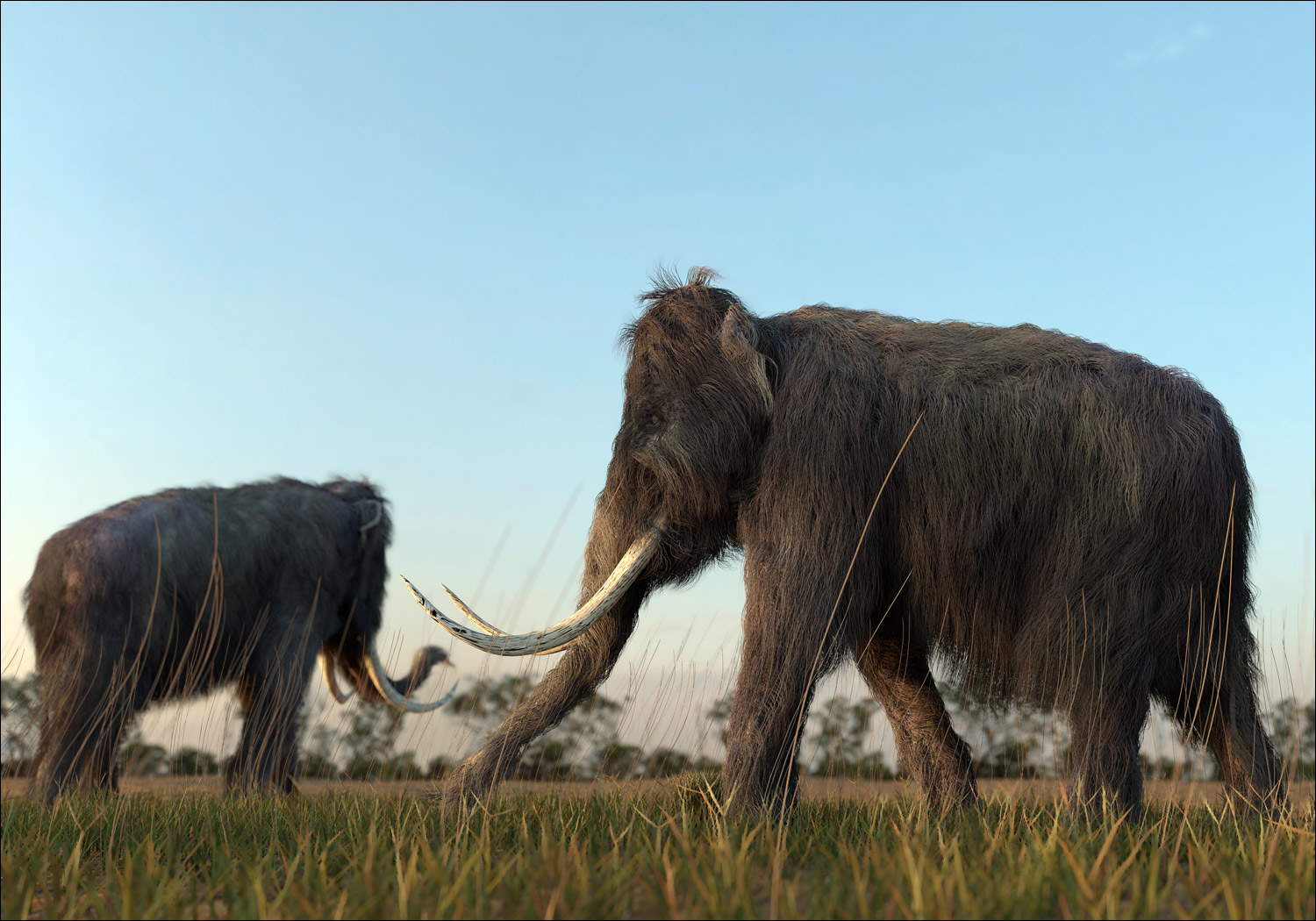
Our elephant could look something like on the render, only the mammoth's fur was not red like the usual image; he lived not on a glacier, but nearby; there was a hump of fat on the neck; ears are smaller; and the tusks are "twisted".
Ivanitch was a slightly fuller (than a skeleton) and cute fluffy creature. It is possible that he was even fat, but this is inaccurate. What is certain is that his coat was about 90 centimeters long, plus there was also a thick undercoat. Among other things, it is this cool property that makes a member of the elephant family a mammoth. More precisely, a woolly mammoth.
Why does he need so much wool? Oooh, it's because there was a glacier nearby. No wonder that frost-resistant elephants appeared, right?
Frost-hardy elephants
Elephants are easy to distinguish by their trunk. This is such a healthy bullshit that sticks out in front of the head. It has an odor sensor inside it, a bunch of muscles and nerves, which allows modern elephants to deftly take bananas from children and carry logs. The trunk is actually a muscular extension of the upper lip and nose.
There were quite a few elephants, and they were very different. For example, the mastodon could boast as many as 4 tusks and special protrusions on the teeth, and some mammoths - the very thick and silky wool that does not fail in any weather. It is important to understand that modern elephants are not descendants of hairy ancestors. They are different branches of evolution with mammoths with a common ancestor.
That is, it so happened that a long time ago there was something big and bald, and then it began to adapt to the changing world and gave rise to several versions.
Perhaps it looked like this: the closer to the glaciers (which were on the territory of modern Siberia), the more heat must be stored. Accordingly, mammoths began to compete. For you to understand what it means to “compete”, I will note that at first these animals lived in Africa and looked something like this:

Southern mammoth, picture from Wikimedia Commons
Then in the Pleistocene the steppe separated from the southern mammoth, which went to conquer the territories of Kazakhstan, Stavropol and Krasnodar Territory ... Actually, one of these can be seen in Astrakhan in the museum. True, he is not very friendly. Another version of the steppe atrocities in the Americas - this is how the Colombian mammoth appeared.

Steppe mammoth, picture from Wikimedia Commons. Lush hair on the tail is already there.
: , , . , — .
The main feature of the steppe mammoth was that it ate grass much better, and could feel quite normal where there are no trees. This made it possible to expand very strongly to the north. The old southern version of the mammoth was eventually supplanted by this fork. And then, on the basis of the steppe mammoth in Siberia, a completely fresh version of the woolly mammoth appeared (intermediate versions are the Khazar mammoth, Mammuthus intermedius). Woolly was able to quickly and quickly overgrow with thermal insulation for the winter and throw it off as it warmed, plus he stored fat not just somewhere in the middle, but in exactly such layers to further isolate the internal organs. And it was smaller than the southern one. Legs were better suited for walking on soft ground.
As a result, the woolly ousted the steppe one much faster.
It's good to be a big milk: you can effectively bask and live where not everyone can get. On the one hand, this put the mammoth out of competition with predators, but on the other hand, it greatly increased energy consumption. "Very" means 180 kilograms of feed per day. In fact, due to the cold and dryness of the plants, there are more. The modern African elephant eats between 100 and 300 kilograms of papyrus and cattail per day, plus drinks between 100 and 220 liters of water. Ivanovich and his relatives were about the same size by sight, but weighed more, that is, they had to look for food constantly (Ivanovich personally reached 5 tons after a hearty dinner). They ate mainly grass and something like a willow, but they did not disdain to darken the tree if they entered the undergrowth. Actually, it is assumed that tusks of such a strange shape were needed in order to immediately push aside a huge layer of snow and find grass under it.And the hump of fat on the neck was needed to conserve water (but this is still a guess). The camel has approximately the same mechanism, only the camel did not meet frozen rivers so often.
Ultimately, it seems that mammoths died out from a combination of reasons, the main one of which was hunger. Ivanych's relatives appeared in Siberia 200-300 thousand years ago, inhabited all available territories near the glacier. As far as is now known, there was a tundra-steppe zone to the south, through which it was possible to safely reach Vladivostok. Which, in fact, did the elephants. At least, they definitely reached Irkutsk. The mammoth from Taimyr was recognized as an exemplary woolly mammoth and became the standard of the species. Then the glacier ended, and mammoths began to end - from 20 to 10 thousand years ago, the woolly ones came to an end. Ivanovich did not find this, he became an exhibit in storage about 30 thousand years ago. Other types of mammoths survived almost before the advent of the Internet - on the islands of the Arctic, remains were found that dated back to plus or minus the 7th century.
Other animals that lived next to the mammoth survived. I mean, some. For example, fluffy unicorns (sorry, Coelodonta) did not master the change in flora and ended up in a museum in Chelyabinsk. Nearby, a cave bear felt on himself what selection was: the beast was big, strong, terrible, horror, omnivorous, but only slow. It’s probably a shame to feel completely invincible, but unable to catch up with anyone. Before that, the bear ate raspberries (and plants in general), dragged honey from bees, and in winter sometimes it still caught some hoofed animals stuck in the snow. But in the new world there was no place for him. At a speed of 25 kilometers per hour in a jerk, he could only catch up with a cyclist, but then cyclists were not found.
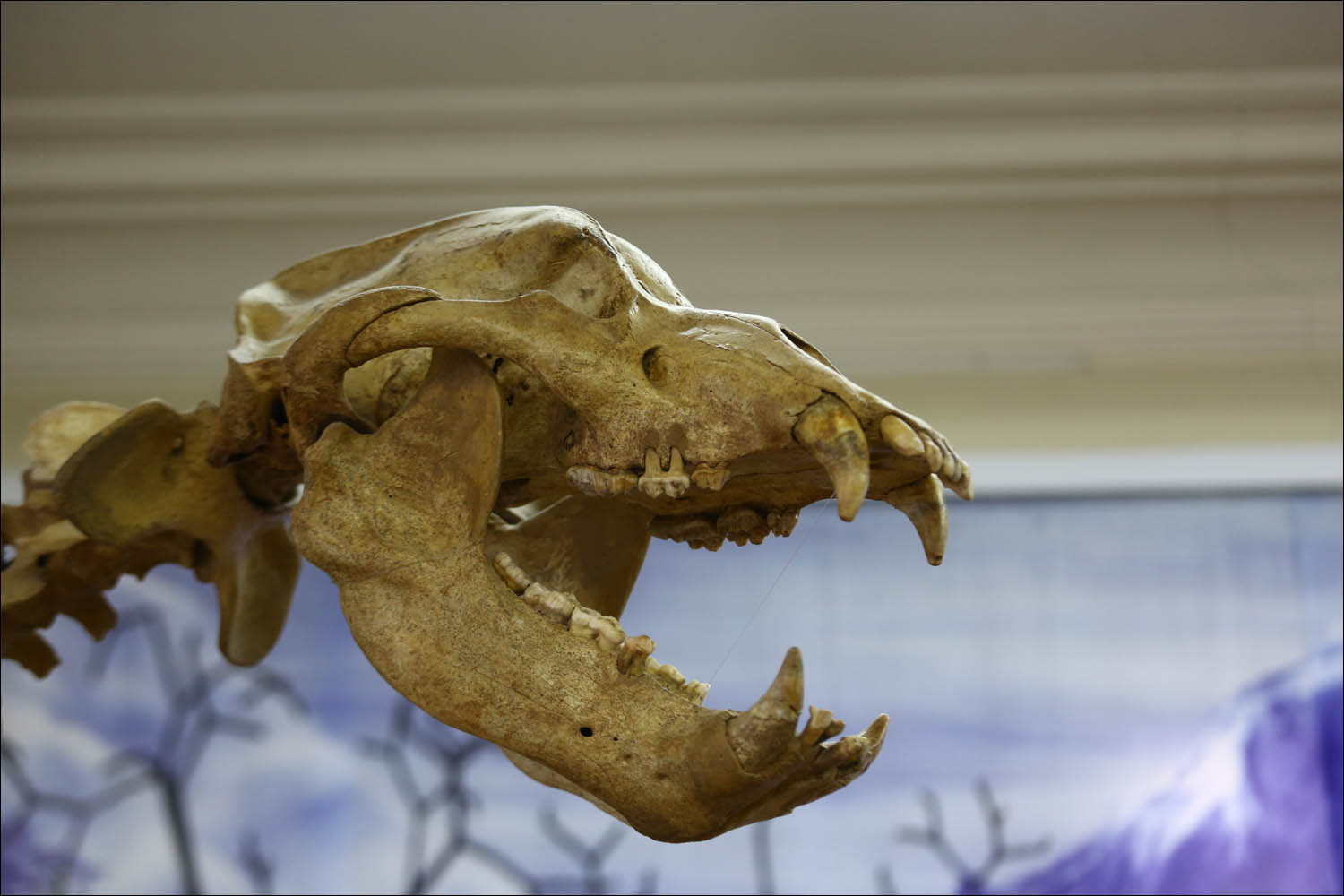
Thanks to this cunning face, many people mistake him for a dinosaur. The bear is named by the inventory number, only the mammoth has a name.
The saigas survived (I have already written about them in more detail ). Many cats survived. By the way, then there was a cave lion, which had little in common with the modern one, but was 2 meters long. This did not allow him to hunt a mammoth, but it allowed him to arrange a gop-stop in the spirit of: “Is there a mammoth? And if I find it? " Woolly mammoths lived in groups (it seems, with females at the head), men sometimes went one by one to see what was in the area. The groups were constantly moving. By the way, the tail (at least in modern elephants) is almost nafig they do not need, but its application is as follows: you can weave it with the tail of your mother, and then you will be able to walk almost "holding hands."

Wolves would hardly do anything even to a mammoth.
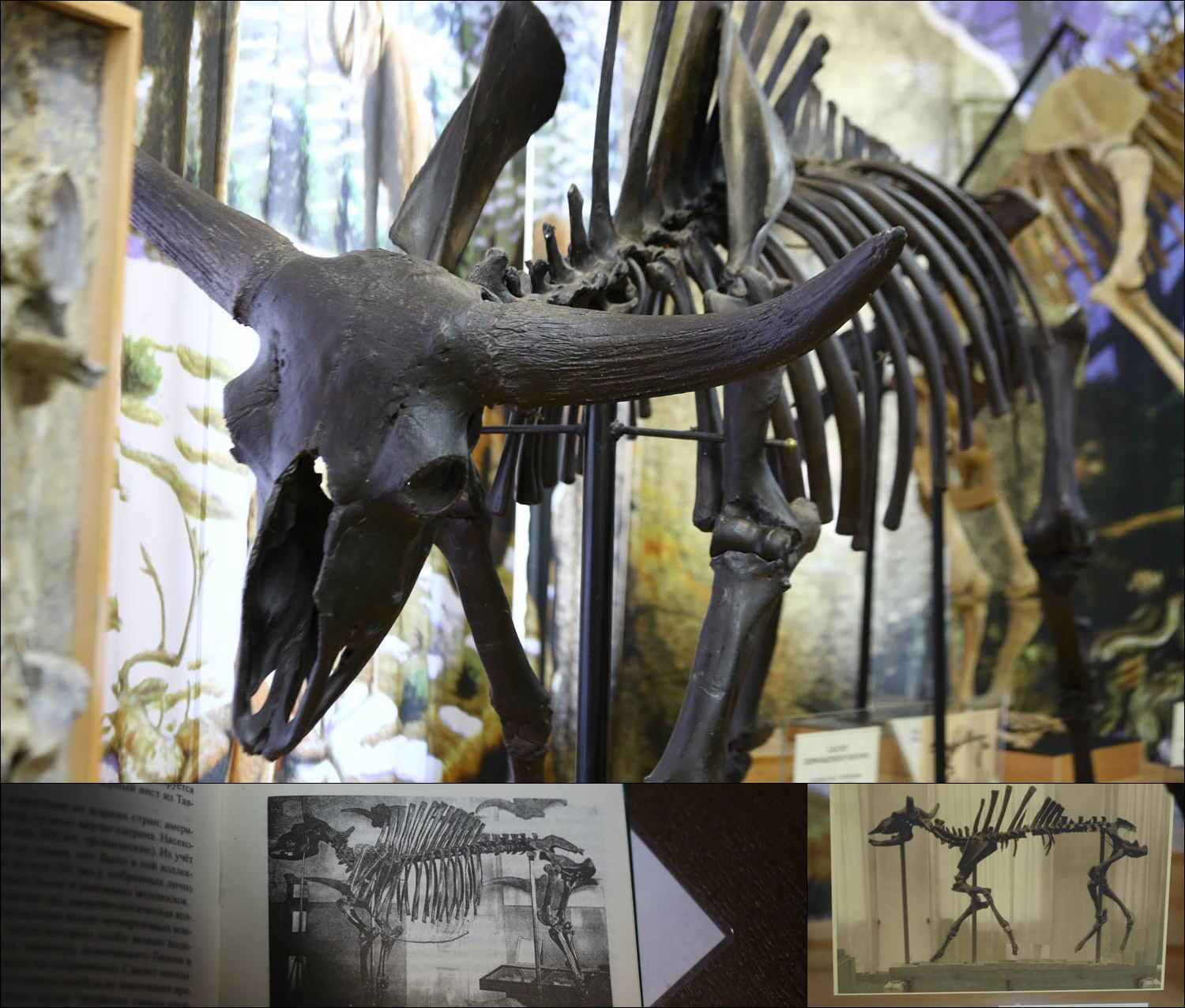
And here is the bison in the museum's collection. This one also became extinct, but already in the 16th century, and it shares a common ancestor with modern bison and cows. Here you can see, by the way, how much he lost in a military hospital.
Reindeer analogs also survived. Still at least wolverines and musk ox.
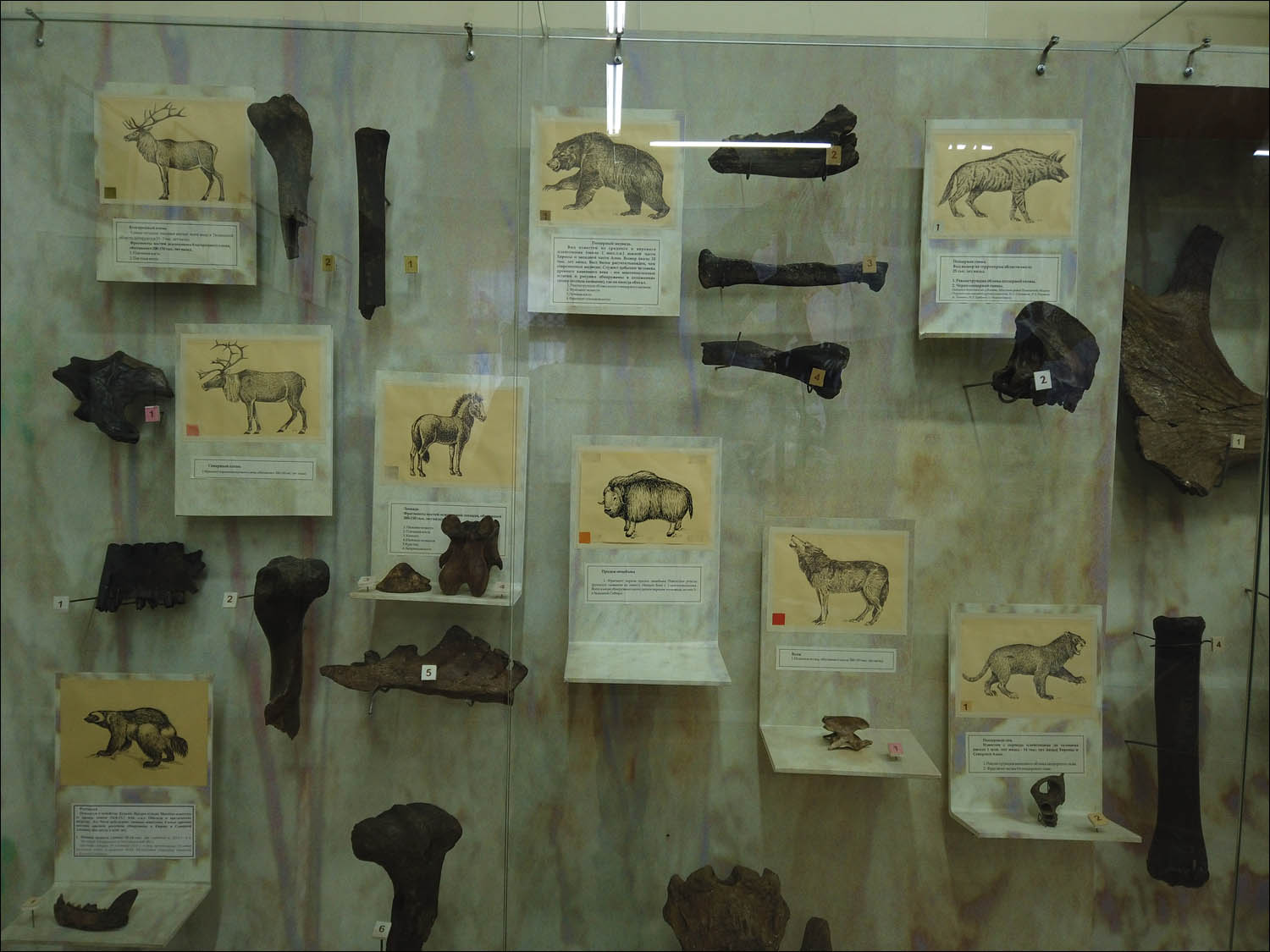
So, as you can see, the elephants have perfectly adapted to the cold, but the cold suddenly ended. The area began to swamp. If before that they ate something like a willow, now this very willow began to be separated by strips of swamps, through which large animals cannot pass. Most likely, thanks to the new fauna, new diseases have appeared. Plus, somewhere nearby hungry already primitive Siberians wandered around and out of hunger, no, no, they gnawed at the strayed mammoth. I mean, they could. It is not clear whether they hunted on purpose or simply butchered the found carcasses into useful materials. In North America, there was almost certainly a whole culture of mammoth hunters, where, in the absence of other game, they went after the elephant. But in our country, it seems, people in the very extinction are almost out of work.
There is a version that mammoths tried to adapt to new conditions, shrinking, and even a new species appeared - a shredded mammoth. It is unclear whether this is so, but this process should not be confused with insular dwarfism - for example, Mammuthus exilis. In short, there is less food on the islands, but there are no predators. And elephants swim well, that is, they can get to the islands. Well, further you can become smaller, since no one will interfere with this.
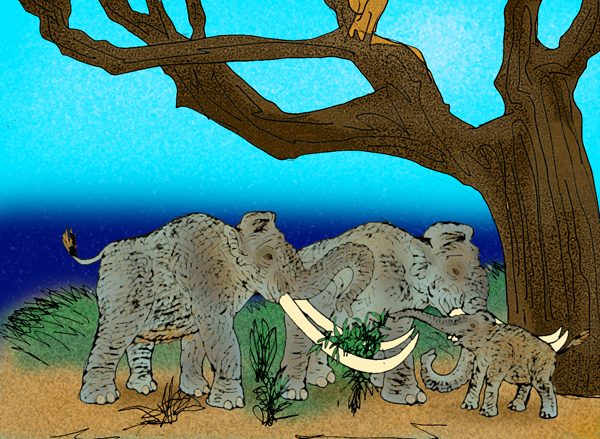
Mammuthus exilis seems to be from Crete, thanks to Vicky
Ivanych
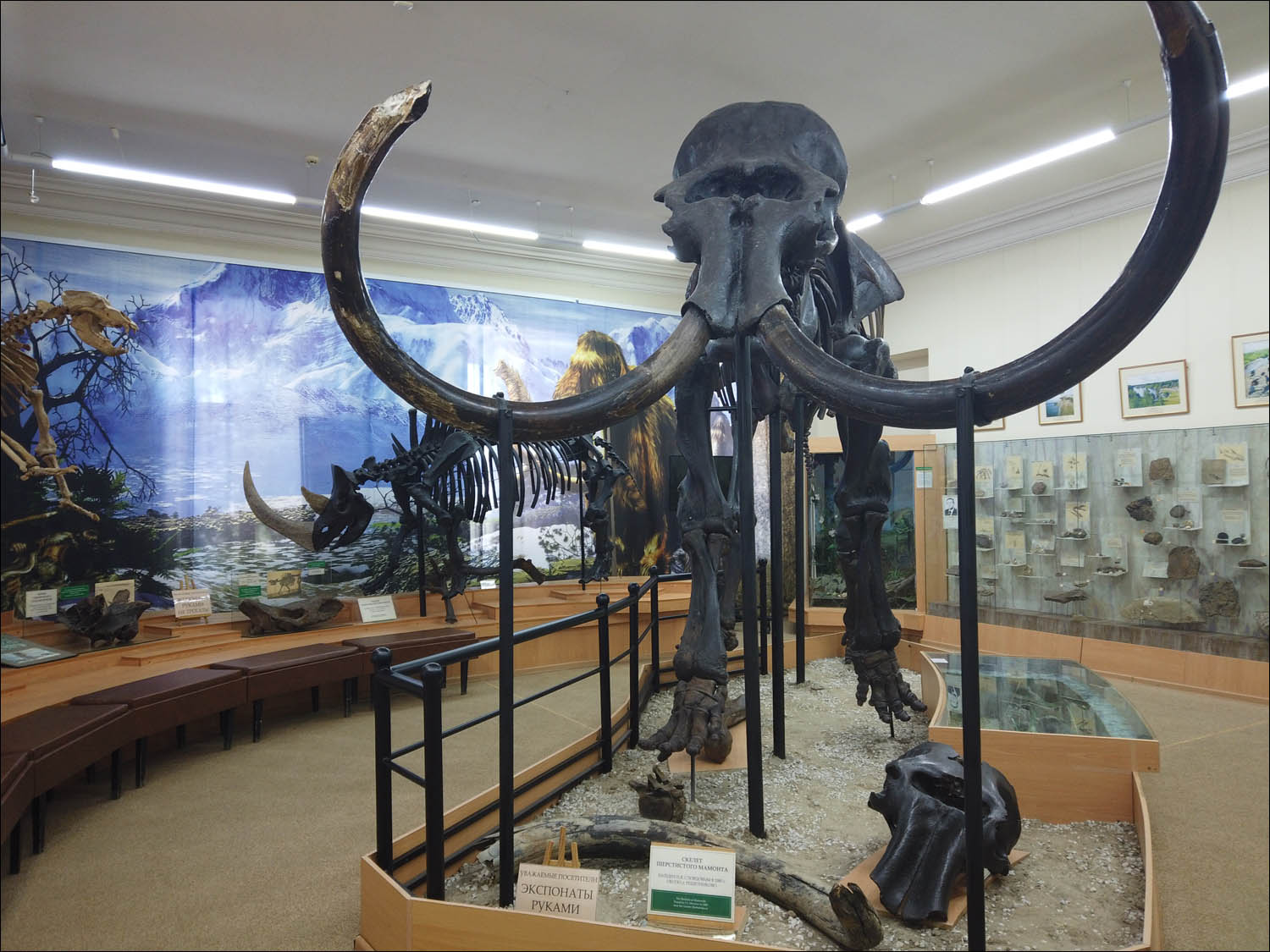
“Children sometimes get scared of Ivanitch. Large." In the background is a woolly rhinoceros.
1885, the heyday of the Russian Empire. Tyumen is the capital of villages, they do not yet know about any oil, but they have already learned how to grow cereals, which made Siberia a fertile region of the world. More and more villages are being established in the vicinity of the city. In the area of the village of Reshetnikovo, they found some unhealthy large bones in an assortment. An experienced person from Tyumen, the director of a real school, left for the place. They called him because he was interested in archeology. Comes - and there, wow, a whole mammoth. He carefully unearthed it and brought it to Tyumen, put it in the hall of the school to welcome the applicant. The name of the director was Ivan Slovtsov, the patronymic of the woolly elephant came from him.
To make you understand the situation, the find was interesting for its integrity, not uniqueness. At the same time, there was a bone carving factory in Tobolsk. More precisely, until the end of the nineteenth century, bone carvers worked in small groups, and the first factory appeared in 1874. They cut a lot of different bones, but among other things, they organized special expeditions to harvest the mammoth. We just walked along the river bank and looked for where the tusk was sticking out.
By the time Ilyich spoke from Bgonevich Ivanovich and his bison friend, they managed to collect, but the already familiar rhinoceros was still lying on a shelf in several boxes.
After the revolution, it was decided to move three friends to a new museum, which was made in the building of the old city duma (the Soviet center later appeared in another place). In Tyumen, in general, wherever you stick, there is some kind of center everywhere. In general, Ivanych was dismantled, then assembled as best they could and exhibited until 1941. In 1941, the museum was converted into a hospital. They did it quickly, so they simply sawed off the supports, the skeleton collapsed, broke, it was collected in boxes and taken to the shed. In 1943, the building was returned to the museum. We gradually began to recreate the exposition. The mammoth returned, but not all. Some of the small bones were lost (goodbye, fingers and tail), but at last we have assembled a rhinoceros. In 1949, the paleontologist Vadim Evgenievich Garut came to "treat" Ivanich (he was the leading paleontologist of the USSR). Then it was concluded that this is one of the most complete skeletons.And that the mammoth in Tyumen is the largest of the other mounted skeletons. Despite the fact that the mammoth has already suffered losses.
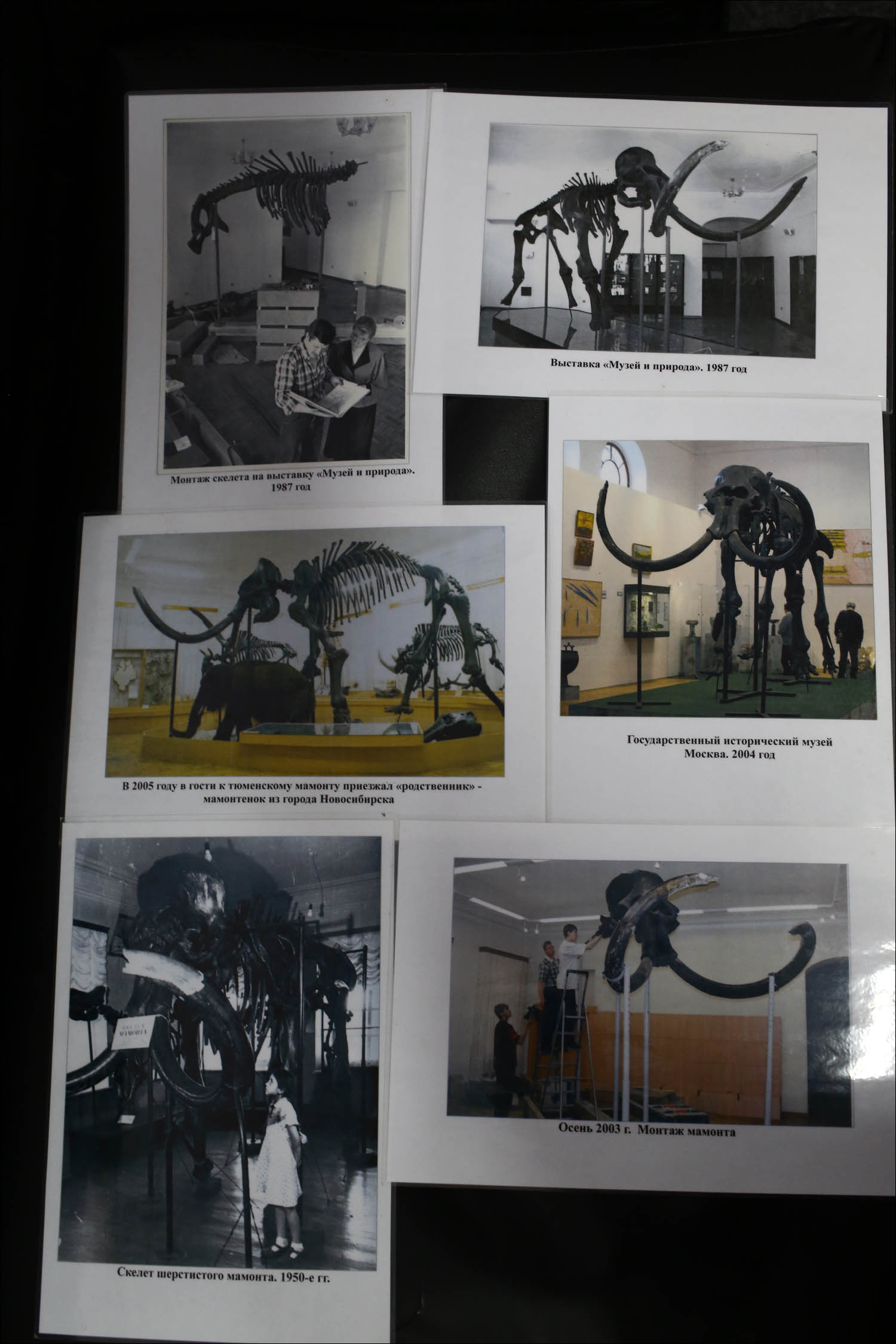
In 84, the museum building was closed for major repairs. The expositions were dismantled. After that, in 1987-1988, Ivanitch was reassembled in another hall (on the second floor). In the process, once it was dismantled, at the same time restored. They were restored with metal staples and plaster of paris; donor ribs from other mammoths were taken for the ribs. They are already unnecessary for them. Moreover, several thousand years. They inserted their teeth, and then what they were lying separately. The cervical section was assembled differently, the head was raised, and inside they put a metal plate, a plaster of paris and (according to legend) a jar of baby food with coins and a note for future restorers in it. Such chaos happened because it was restored by taxidermist Yakovlev and junior researcher Pavel Sitnikov - there were no real paleontologists around. In 2003, the museum was closed for major renovations (hello,royal sewerage!), and the skeleton was taken to Novosibirsk at this time. There it was restored by a stern man - Igor Grebnev. If there was a jar, and if he got to it, then now the jar is not there, because it was not in the original mammoth either. But there are still some chances that he did not get there.
In 2004, Ivanych represented the Tyumen region at an exhibition in Moscow. He was pretty much replenished with new ribs - yes, only his "native" details were left, but an artificial remake was added.

Here you can see a small chip of polyurethane foam, from which the fingers are made.
At the same time, the skeletons of a bison and a rhinoceros were restored. In parallel, a skeleton of a cave bear was found on an expedition in 2003.

Guides sometimes have a 3-kilogram tooth in their pockets that you can touch with your hands. There are many teeth, because in a mammoth they changed up to six times in a lifetime, and new ones squeezed out old ones as they grew or grinded down. That is, the elephant walked, walked, walked, then spat out a tooth with a gloomy face and walked on.

At the top is a characteristic grater-type chewing plate.
By the way, the find with a "tooth to touch" is excellent, by this the museum helps children to grope and save more valuable exhibits. In general, the struggle between the forces of good and the forces of reason is noticeable: at the entrance there is a sign that the exhibits have been processed with a special unkind composition, but the fingers of the same rhino were still broken off. Because they were performing. As an employee of the museum says, this is something else, there are more problems in the stuffed animals at the neighboring exposition: “We regularly smooth the otter!”
The dust from the elephant is cleaned every six months with a stepladder. The air in the museum is ordinary, it is not cleaned in any way, the windows are often opened due to the ventilation system inherited from the king.
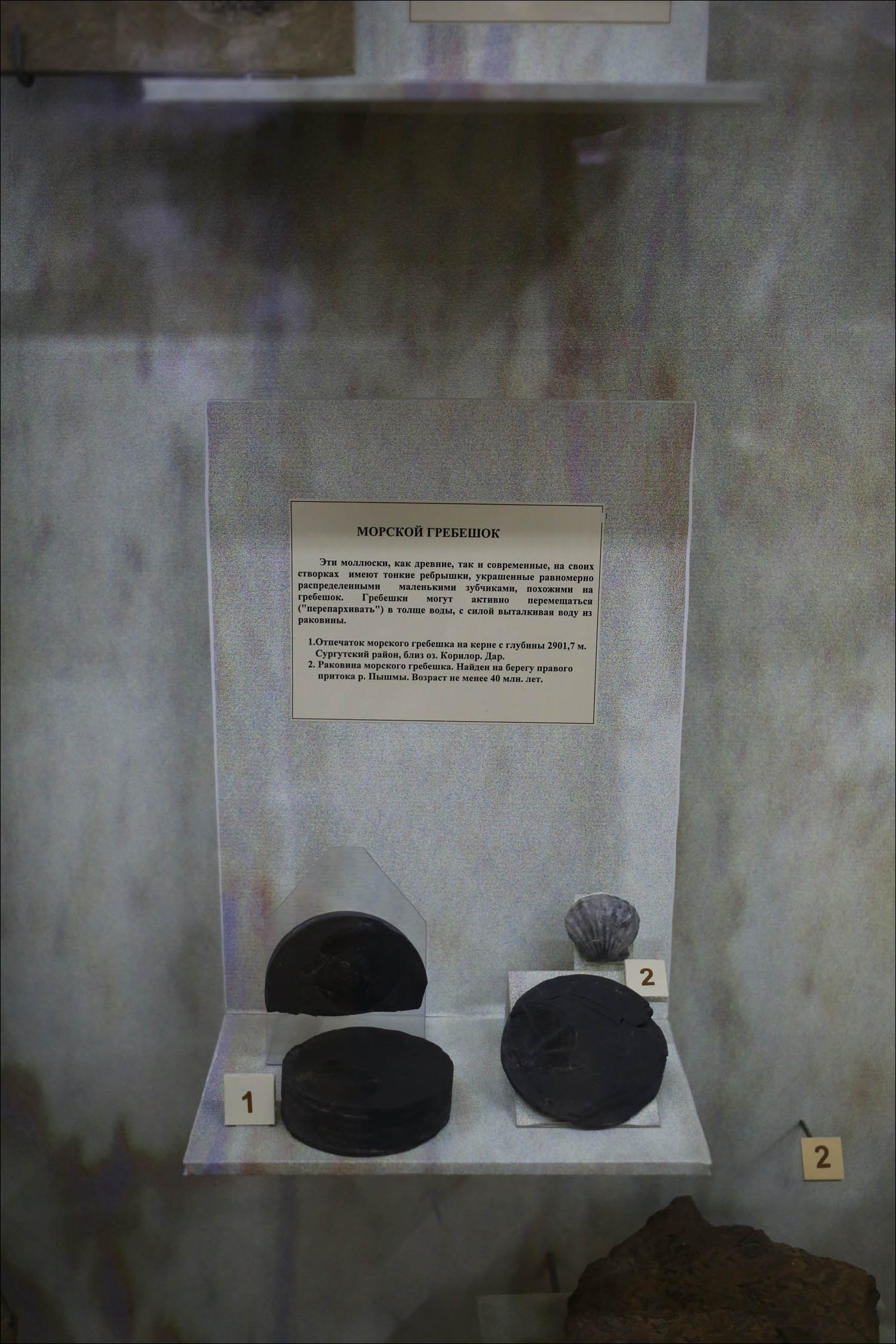
« » , . — , , .
, -?
Mammoths lived on our territory, died out here and survived well enough in the permafrost. Which, by the way, ultimately made it possible to get first mitochondrial DNA, and then nuclear. That is, we already have the full 13 GB mammoth code (base is 2 bits, a person has 3.1 GB). True, in some places, possibly contaminated with the bacteria code. But this is already an application for a transgenic descendant with an Indian elephant.
On the territory of the former USSR, at least 30 mammoths are exhibited in museums. Two coats of arms in Yakutia have mammoths (Srednekolymsk and Ust-Yansky ulus). At the end of 2019, 120 tons of mammoth tusks were exported from us, judging by thesedata. All sorts of figurines are cut from the mammoth tusk, plus it goes into folk medicine, guess which fraternal people. In the same Tyumen, new finds occur quite regularly, since the rather steep banks of the river constantly crumble and allow you to see protruding tusks. Here it is said that in Yakutia alone, about 100 tons of tusk are mined per year, of which 30% is illegal. It also indicates that the market value of a mammoth tusk weighing 50 kilograms is about 15 thousand dollars. And tusks do not usually lie one by one, if that. Now they are thinking about legalizing mining - this, oddly enough, will allow scientists to receive both taxes and profits. Well, by design, at least as it will drastically drop the black market prices.
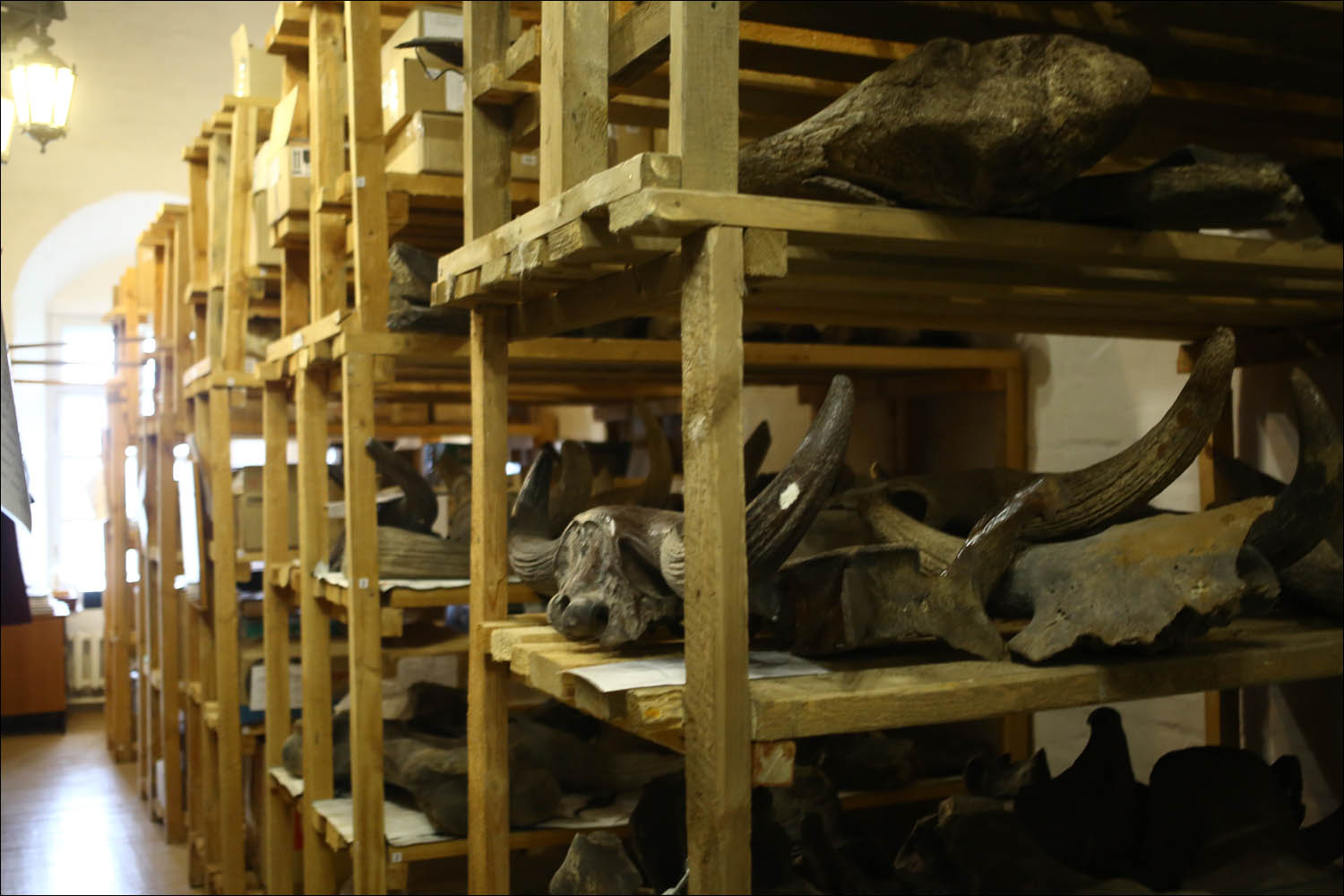
A rental in Tobolsk, the most interesting details from various animals are stored here.
Interestingly, under the tsar, we also exported a lot of ivory for cutting, and this despite the fact that there were no elephants in the Empire. And the fact is that the “ivory” product group also included walrus tusk, and we were selling it. The margin, they say, was equine. Now we are almost finished (you cannot touch the walrus), but we continue with the elephants. Well, as you know, the number of finds of various spare parts from woolly mammoths is simply off scale - although the same shark teeth from prehistoric seas are difficult to surpass.
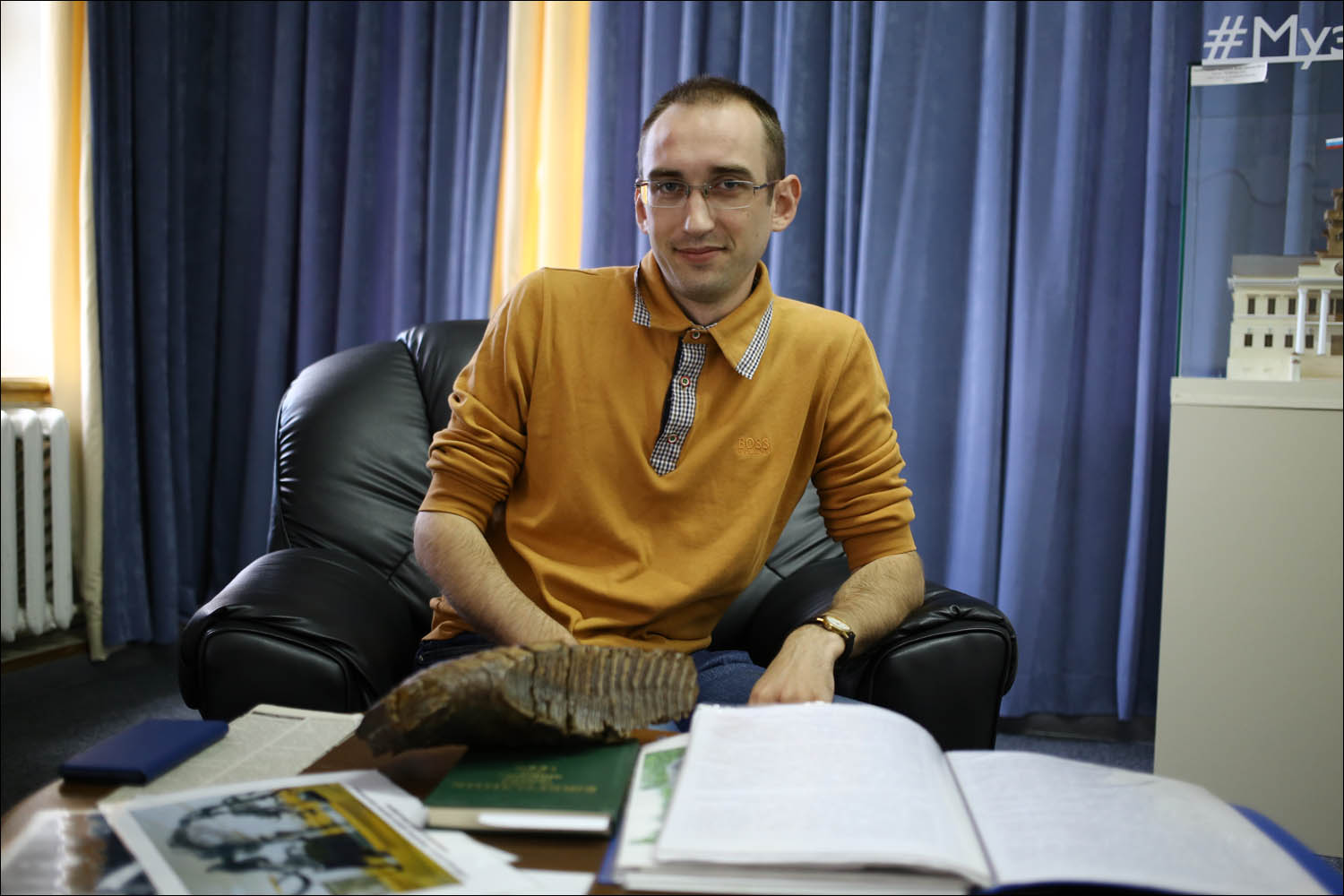
Grigory Nagibin, a methodologist for museum educational activities of the City Duma museum, was with us. We are both not paleontologists, so it is possible and necessary to correct all of the above.
Ivanovich's birthday is November 30, you can come to visit the museum and blow out a bunch of candles at once. They bet, however, not all 30 thousand, but only by the number of full years since the discovery. The last time the schoolchildren enjoyed four cakes at once.
PS If you are interested in more about Tyumen, then here is " Checklist " - a joint project of us, Rostourism and TV Brix.